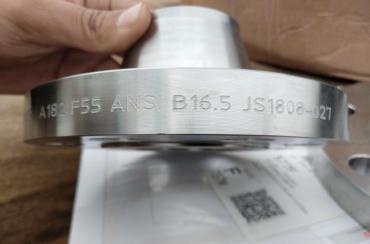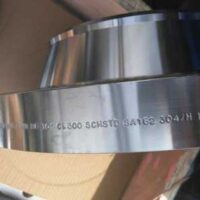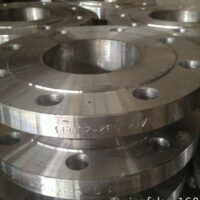Description
Duplex & Super Duplex Stainless Steel Pipe Flanges
ASTM A182 SA/A182 F50, F51, F60, 2205, F61, F53, 2507 & F55 Duplex & Super Duplex Steel Flanges
Cangzhou wilson pipeline sales@wilsonpipeline.com Is A Global Leading Manufacturer For Your Duplex Stainless Steel Flanges Requirement.
Duplex Steel
Duplex stainless steel is a very useful metal that has been used worldwide. It gets its name because it contains two different grades of metals.
In essence, Duplex is a Fe-Ni-Cr alloy with a two-phase ferritic-austenitic stainless steel structure at room temperature.
Duplex steel is characterized by high chromium content (19-28%) and molybdenum (maximum 5%), and the nickel content is lower than that of austenitic stainless steel. The most commonly used duplex stainless steels are 2205 (22% chromium, 5% nickel) and 2507 (25% chromium, 7% nickel). 2507 is called “super duplex steel” because of its higher corrosion resistance.
The advantage of combining ferrite and austenite grades is that the resulting metal has a metallurgical structure composed of two phases and therefore benefits from the characteristics of both microstructures.
These characteristics make duplex steel highly sought after in heavy industries such as oil and gas nuclear and chemical processing.
Advantages of duplex steel
Duplex stainless steel has many advantages, such as:
Strength: The strength of duplex stainless steel is about twice that of ordinary austenitic or ferritic stainless steel.
Toughness and ductility: Although duplex stainless steel is not as good as austenitic grade, its toughness and ductility exceed ferritic steel.
Corrosion resistance: Like all stainless steels, corrosion resistance mainly depends on the composition of the stainless steel, of which chromium, molybdenum and nitrogen content are the most important. Duplex stainless steel has strong corrosion resistance, even in chloride and sulfide environments, duplex stainless steel has high stress corrosion cracking resistance (SCC). SCC is a type of corrosion that occurs when the following specific factors are present: tensile stress, corrosive environment and sufficiently high temperature.
Heat resistance: Duplex stainless steel has higher thermal conductivity and lower thermal expansion than austenitic steel. Duplex stainless steels can be easily used at temperatures of at least -50°C because they are more ductile than ferritic stainless steels at low temperatures.
Cost: The nickel and molybdenum content of duplex stainless steel is lower than that of austenitic stainless steel. The lower alloy content means that duplex stainless steel can reduce costs. In addition, due to the increased yield strength of duplex stainless steel, its thickness can also be reduced. Thinner products mean that weight can be greatly reduced.
Weldability: Duplex stainless steels tend to have good weldability. Although they are not as easy to weld as austenitic stainless steels, all standard welding processes can be used.
Application of duplex steel
The wide range of advantages of duplex stainless steel means that it can be used in many different fields. They are used for:
Chemical processing, transportation and storage
Pipelines for oil and gas production and transportation
Oil and gas exploration and offshore drilling platforms
Oil and gas refining
The marine environment
Pollution control equipment
Pulp and Paper
Chemical processing plant
Structure and mechanical components
Heat Exchanger
Cooling pipe
Types of duplex flanges
Duplex Weld neck flange
Their uniqueness lies in their protruding neck. The long welded neck flange has the same thickness as the pipe, making it ideal for severe working conditions (such as high pressure).
Duplex Threaded flange
They are only used for special applications. It is worth noting that you can quickly assemble threaded flanges without welding. As the name suggests, they are compatible with pipelines with external threads. Unlike welded neck flanges, threaded flanges are not the right choice where high pressure, high temperature and bending stress are involved.
Duplex Slip on flange
If your budget is tight, consider using a slide-in flange. They are the most affordable, but still get the job done. It must be a bit larger than the pipe to make it easier to slide through the pipe. These flanges are welded to one location by fillet welding and cannot withstand high pressure.
Duplex Lap joint flange
They are a slip-in flange, but are used with short end joints. They are ideal for systems that require regular inspection and maintenance.
Duplex Socket weld flange
They are very durable and very suitable for small diameter and high pressure pipelines. They have internal welds to enhance their durability and fatigue strength. They are mainly used in the chemical processing industry.
Duplex Ring joint flange
These flanges can withstand high pressure and high temperature. They have a groove that can be easily compressed on the binding, sliding or welding neck flange. They help avoid pipeline leaks under high pressure.
Duplex Orifice flange
These flanges can lead to metered liquid or gas lines. They are installed with orifice plates or flow nozzles.
Duplex Blind flange
The blind flange has no holes and is used to seal piping systems or containers. The blind flange must withstand high stresses due to internal pressure. They can be used in systems that require regular inspections.
Sizes: 1/2″ – 36″ +
Bores: S/5s – XXH
Duplex Flange Rating
Pressures: 150# – 300# – 600# – 900# – 1500# – 2500#
Duplex Flange Dimensions
Duplex Flange Bolts
Duplex Flange Weight
Duplex Flange Grade
Trade Name
DUPLEX
DUPLEX
2205 DUPLEX
SUPER DUPLEX FERRALIUM 225
SUPER DUPLEX 2507
SUPER DUPLEX ZERON 100
Forged Fittings
A/SA182
A/SA182
A/SA182
A/SA182
A/SA182
A/SA182
F50
F51
F60
F61
F53
F55
Flanges
A/SA182
A/SA182
A/SA182
A/SA182
A/SA182
A/SA182
F50
F51
F60
F61
F53
F55
Duplex Flange Price




